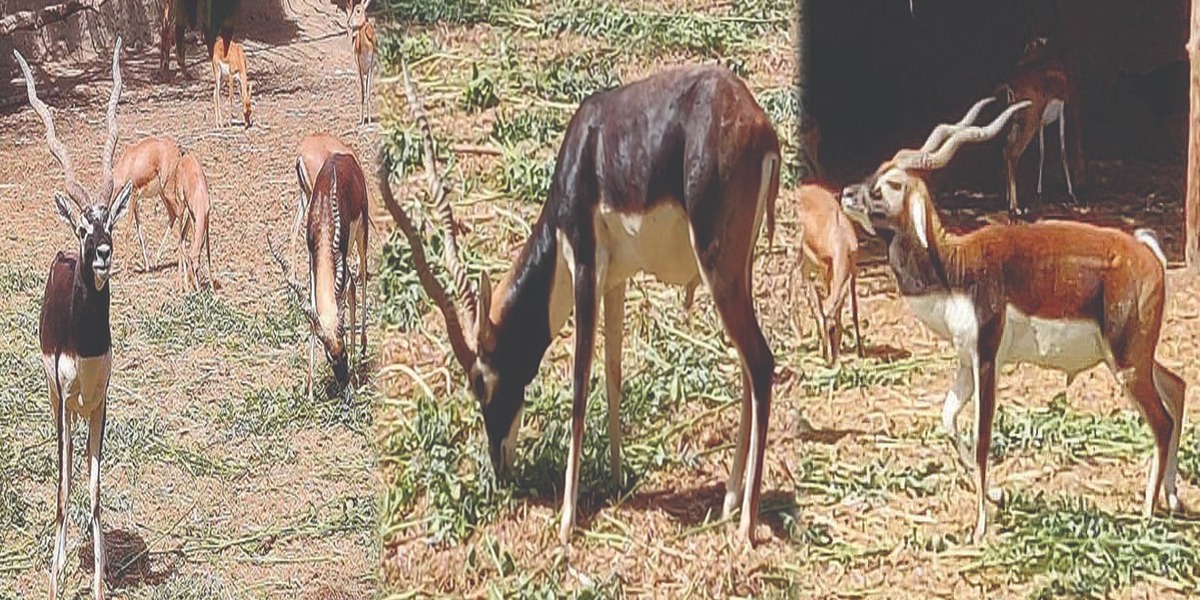When we talk about a deer, usually a red deer comes to mind. But the blackbuck – a species of antelope native to the Indian subcontinent – is also a masterpiece of nature. The blackbuck is primarily found in Pakistan, India and Nepal.
A young blackbuck is around two-and-a-half to three-feet high at the shoulder; weighs around 70kg to 75kg and is four- to five-feet-long. The upper part of its body is black while the lower part is white in colour – a quality which adds immensely to its beauty.
Horns of the blackbuck are straight, long and ringed. In its natural habitat, the beautiful herbivore is preyed upon by predators like leopards, cheetahs and wild dogs.
It was found in large numbers in desert areas of Pakistan particularly Bahawalpur, Khairpur and Sukkur but its population started shrinking due to constant hunting. In 1947-48 the number of black bucks in the subcontinent was about 90,000 which was reduced to 8,000 by 1965.
The government of Pakistan, India and Nepal later made some efforts to protect the blackbuck whose number increased to 25,000. But indiscriminate hunting by royalties from gulf countries as well as local vassals in Pakistan greatly reduced its number once again.
In 2003, the International Union for Conservation of Nature listed the blackbuck as near-threatened. However, local poachers and influential people still try to target this animal and sometimes even post videos of the hunting on social media sites.
At present the number of the black buck in Nepal is limited to a few hundred. In India, there are more than 7,000 blackbucks while in Pakistan the blackbucks are said to be around 2,000 to 2,500. These animals are both in privately protected areas as well as national parks established by the government.
The desert of Salehpat extends from Sukkur district to Sanghar district in Sindh province and from Rahim Yar Khan district to Bahawalpur district in Punjab province. In the east, Salehpat meets the Indian province of Rajasthan.
The red deer as well as blackbuck were found in large numbers in this desert before indiscriminate hunting led to their near extinction. In this scenario, Samo Khan Bhanbhro – a well-known political and social figure of the area – took the initiative to save the deer from extinction.
Bhanbhro, who also served as the nazim of Salehpat tehsil during the General Musharraf era, set up a farm on about 60 acres to protect the deer. He also cordoned off the area to protect it from poachers.
These efforts of Bhanbhro later bore fruits as the population of deer started to increase in his enclave. Now there are more than 200 red deer and blackbucks at Samo Khan Bhanbhro’s farmhouse. These animals are fully monitored with Bhanbhro’s employees, who provide them food and protection.
“If any deer gets sick, a veterinarian is called immediately and the sick deer is treated,” said Bhanbhro.
“Deer are the beauty of this desert but people hunted them cruelly. These deer were disappearing from here so I had to take this step so that no one in this area should hunt deer now,” he added.
He said he did his best to protect the blackbucks and red deer. “I was trying to stop poaching. Blackbucks are rare and their lives should be protected. They are fed and protected in this enclave and I am glad that the beauty of this desert – the blackbuck – is safe here.”
This effort of Samo Khan Bhanbhro is certainly commendable but there are still reports of the presence of the blackbuck and red deer in this desert which spreads to Punjab.
It is now the responsibility of the wildlife department and other relevant government agencies to take steps to protect the remaining members of this endangered species.
Pakistan is fortunate to have a rare breed of blackbuck and some of them have been protected due to personal efforts of some individuals like Samo Khan Bhanbhro.
However, the government should also take steps at federal and provincial level to save the blackbuck. Immediate measures should be taken to save this endangered species.

















